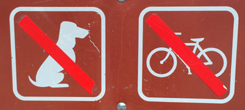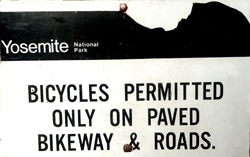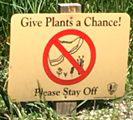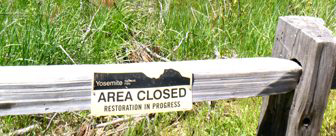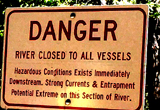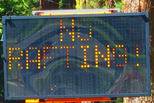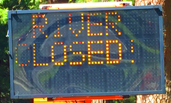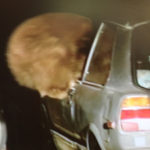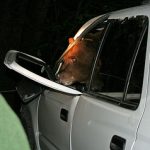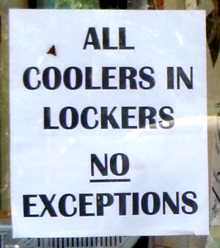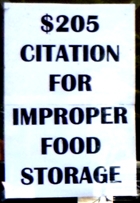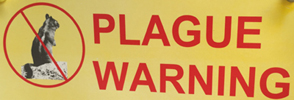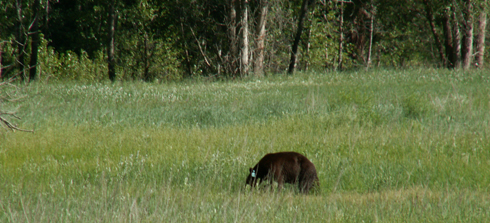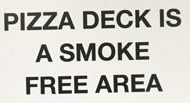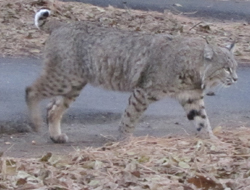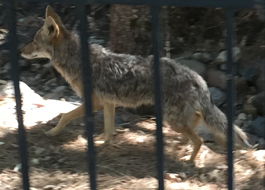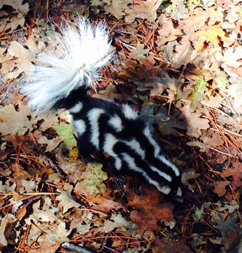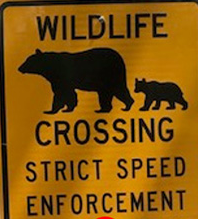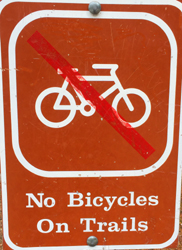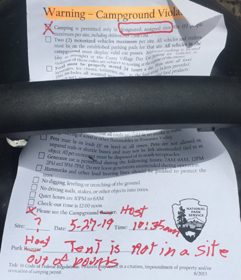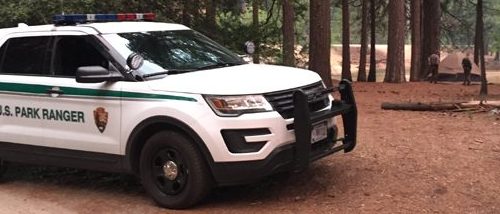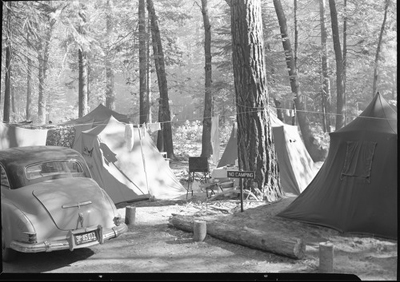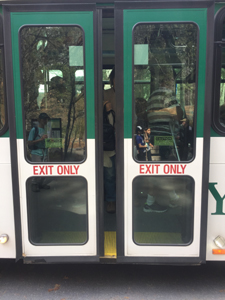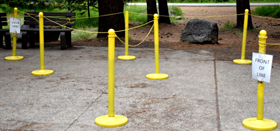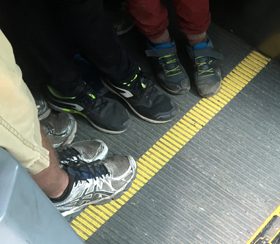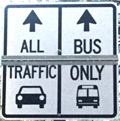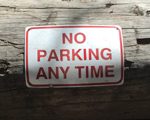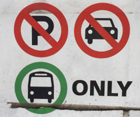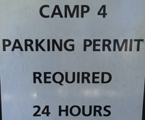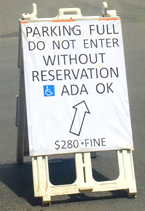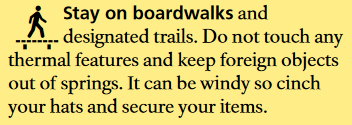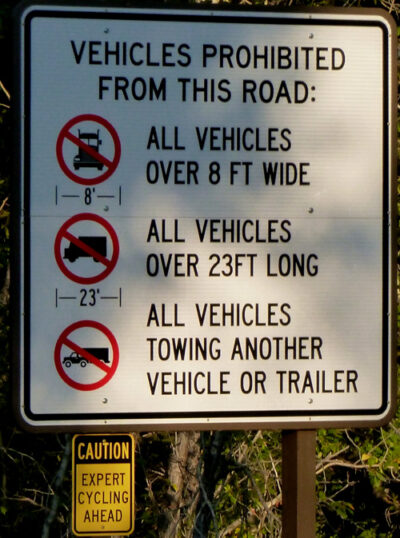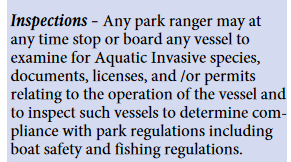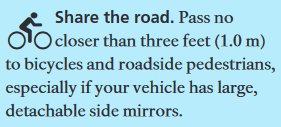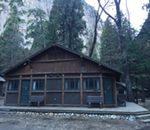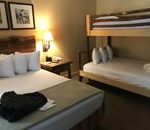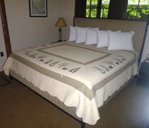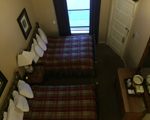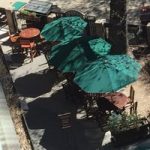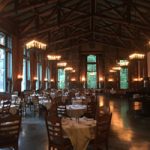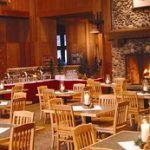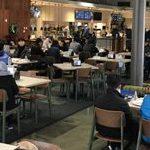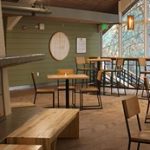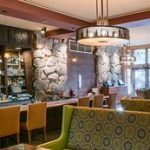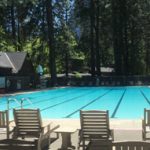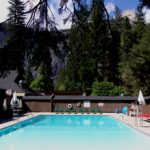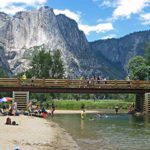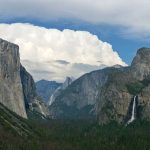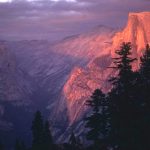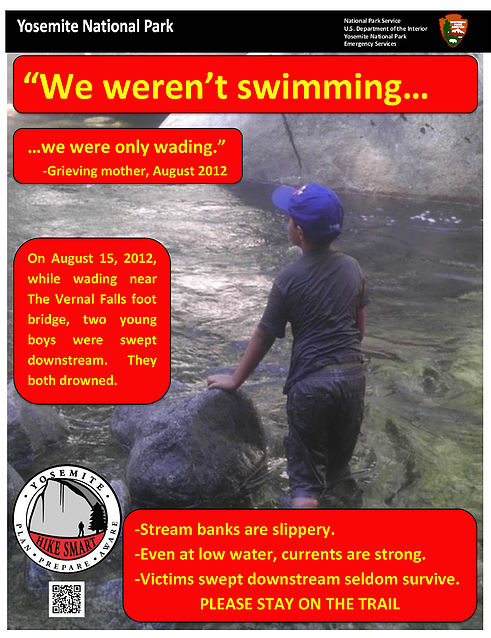As a part of preparation for a trip to Yosemite National Park
people can consult park webpages for the current rules and regulations.
Can I take my dog on a hiking trail, into a hotel room?
Do wild animals really get into people’s food, even when people are nearby?
Can I ride my bike, fly a kite, park my vehicle everywhere?
Why can’t I use a drone or fireworks?
Why aren’t slacklines okay on Oak trees?
Why can’t climbers sleep at the base of El Capitan?
What is the season for stream and river fishing?
This webpage is an index to park websites on most subjects that have
regulations affecting people’s use of the park.
Many of the park websites have the reasons behind the rules.
Most major Yosemite National Park rules, fines / citations, regulations and policies are listed in the Superintendent’s Compendium
https://www.nps.gov/yose/learn/management/upload/yose-compendium.pdf
(The 2018 version was put into place May 31, 2018, the 2019 version on June 16, 2019. I noticed only a few changes from 2018 to 2019. The 2020 version on March 26, 2020. The 2021 version was put into place June 9, 2021. The 2022 version was put in place 8/18/2022.)
ANY of it can change as needed with little notice.
This list of samples from the compendium is here to tempt people to read the Superintendent’s Compendium in more detail but it is not all-inclusive, and may leave out items or parts of items that could be important to some park visitors.
And see below for links to other Yosemite National park webpages with more detailed rules than the Superintendent’s Compendium about pets, bikes, permits, campground regulations, fishing, food storage . . .
You will also see signs with rules and safety warnings, such as these at trailheads (the start of a trail):
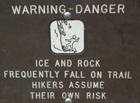
or these reminders to stay on a trail to protect plants:
or this warning, often ignored, at Bridalveil Fall,
(The picture below is from: A Common Yosemite Search and Rescue
where it says: “Danger signs are not there to ruin our fun.
They are often posted in places with a large accumulation of past accidents.”)
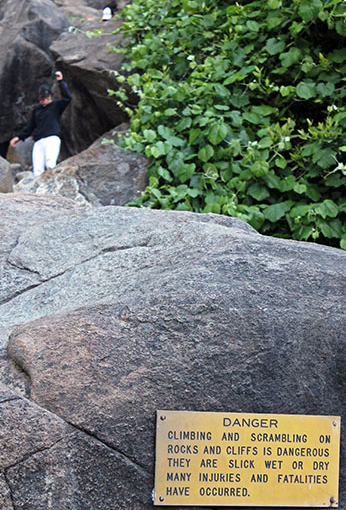
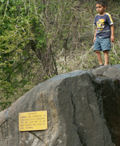
Some times of the year there are warning signs about activities you might have expected to be able to do:
And some times of the year, on your drive into Yosemite valley, a sign repeatedly flashing messages:
You can also read and/or download a copy of the current Yosemite Guide newspaper, before you go on your Yosemite vacation, to make better plans for fun and understand the most crucial rules and safety issues the park service wants people to be aware of. (You can expect to be offered a copy of the Yosemite Guide when you enter the park and might find one at the front desk of a Yosemite valley hotel.)
When moving into your campsite and or picking up your backpacking permit, you will be offered a short list of most important information worth going over with everyone on your trip.
When you check in to a Yosemite lodge / hotel / tent cabin you might see a sign
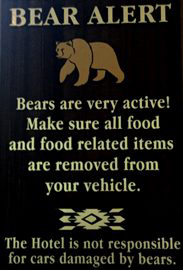
and you might sign a paper including initialing a few sentences saying that you understand, for example
about FOOD STORAGE:
Reading all signs can be important. You might find a sign, such as this one in the window at the Tuolmumne Meadows campground entrance kiosk:
that is different than what the Superintendent’s Compendium in force at that time said:
“If an NPS-provided food locker is full, the occupants of that site or unit may store a clean ice chest that is empty, or contains only plain water or ice, on top of or next to the full locker.”
Right next to it in the window was this sign:
Some Yosemite accommodations require the use of a bearbox (food storage locker) to store food, toiletries etc.
Animals can climb up to hotel room balconies, so no, you can’t store your ice chest or other food on your balcony.
In others you need to be careful that an ice chest does not show to a bear (or . . .) looking in a window. Boxes of crackers, snacks are best stored in a room in a mouse-proof container, again, out of sight.
Likewise, valuables left on a shelf, table, desk in a hotel room / cabin / cottage / vehicle that show through a window are an invitation to a thief.
– – – – – – – – – – – – – – – – – – – – – – – – – – – – – – – – – – –
When a trash bin at an outside dining area is full, find another trash bin rather than piling trash on top, and report it to the management:
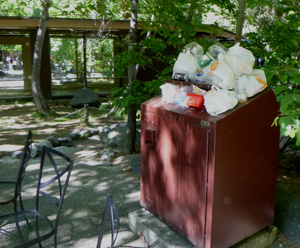
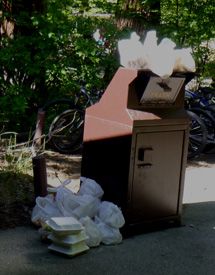
– – – – – – – – – – – – – – – – – – – – – – – – – – – – – – – – – – –
more from the Superintendent’s Compendium:
Prohibited: “Willfully approaching, remaining, viewing, or engaging in any activity within 50 yards of bears, or within any distance that disturbs, displaces, or otherwise interferes with the free unimpeded movement of wildlife, or creates or contributes to a potentially hazardous condition or situation.” The park notes that 50 yards is “about the distance four shuttle buses parked end to end would take up.” What to do if you see a bear is at: https://www.nps.gov/yose/planyourvisit/scarebears.htm” Report bear sightings and incidents to the Save-A-Bear hotline (209)372-0322.” (And please note that other national parks you may visit can have different distances to stay away from bears and various other wild animals.)
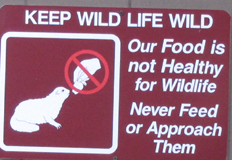
One of the reasons feeding animals is not wise:

The Yosemite National Park rangers would like you to call them
if you see a bear in Yosemite,
no matter where it is or what it is doing.
Since 2003 there has been a note in the Yosemite Guide: “REPORT ALL BEAR SIGHTINGS! To report bear sightings, improper food storage, trash problems, and other bear-related problems, leave a message for the Bear Management team at: 1 (209) 372-0322. Your call can be made anonymously.”
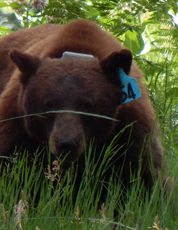
If you can, in all the excitement, try to notice if the bear has a tag (usually on the ear), the color of the tag and if possible, the number on it (the tag is large enough that with a telephoto lens you should be able to read the number).
From the Yosemite Daily Report newspaper:
“It is extremely important to remember to yell at bears that are in and around development, even if they are foraging on natural food. Though it is very tempting to get close for a picture, or just to watch these incredible animals, it is important not to give into this urge. Yelling at them if they are in residential areas or near people is critical to keep bears natural fear of humans. Giving bears plenty of space. When bears become too comfortable around people, they will often start causing damage to structures and vehicles, or will even become too bold around people, creating safety concerns.”
And the Yosemite Daily Report also said:
“Scare bears when you see them. . . in developed areas- Yell like you mean it!
Make as much noise as possible, try waving your arms, stomping your feet
or anything to make you look intimidating and to get the bear to run away.
We know it’s fun to see bears and it can feel mean to scare them,
but this is a simple way to truly help save a bear’s life.”



Mid-summer is baby season in Yosemite National Park. Please do not touch juvenile animals (especially baby birds, ducklings, and deer fawns) and leave them where you find them. Parents will often leave young in search of food but will return. Touching or moving wildlife is illegal and decreases young animals’ chances of surviving into adulthood.
______________________________________________
“The climbing or attempting to climb any giant sequoia tree (Sequioadendron giganteum) is prohibited.”
“Possession of a glass container within 50 feet of any riverbank, lakeshore, on the water, or in a vessel is prohibited. This restriction is necessary for the protection of visitors who frequent these areas in bare feet.”
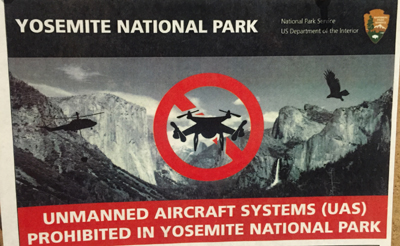 Model airplanes, quadcopters, drones are prohibited: “Launching, landing,or operating an unmanned aircraft from or on lands and waters administered by the National Park service within the boundaries of Yosemite National Park is prohibited except as approved in writing by the superintendent.” Reasons why you can’t play with / photograph with your drone are at: https://www.nps.gov/yose/learn/news/use-of-unmanned-aircraft-systems-drones-prohibited-in-yosemite-national-park.htm
Model airplanes, quadcopters, drones are prohibited: “Launching, landing,or operating an unmanned aircraft from or on lands and waters administered by the National Park service within the boundaries of Yosemite National Park is prohibited except as approved in writing by the superintendent.” Reasons why you can’t play with / photograph with your drone are at: https://www.nps.gov/yose/learn/news/use-of-unmanned-aircraft-systems-drones-prohibited-in-yosemite-national-park.htm
The Park Service has said: “. . .launching, landing, or operating unmanned aircraft (drones) in units of the National Park System is prohibited. . .
“Violation of the ban is a misdemeanor with the maximum penalty of six months in jail and a $5,000 fine.”
“From May 1 through September 30, all wood fires are restricted in Yosemite Valley campgrounds, Housekeeping camp, and picnic areas, to between the hours of 5:00pm to 10:00pm.
From October 1 to April 30, wood fires are allowed anytime.”
Kite flying is limited to kites measuring less than 1,300 square inches and which are tethered by string or similar material less than 150 feet in length. Ahwahnee Meadow, El Capitan Meadow, Big Meadow, and Tuolumne Meadows are closed to kite flying regardless of size. This restriction is necessary to ensure the safety of low flying aircraft being used in SAR, medical, fire, or other emergency situations.” And please do remember that you should try to do kite flying where you won’t damage wildflowers or where your kite will not get stuck in a tree.
“Powerless flight requires a permit from the Superintendent.”

“There is no overnight parking allowed in the Village Store, General Office, Church Bowl or other parking lots as signed.
Visitors with overnight accommodation in lodges or campgrounds may leave their vehicles unattended for the period of their stay as long as permits are displayed.”
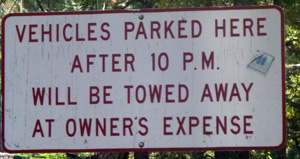
This National Park Service photo shows people sitting at their campfire with their backs turned to food behind them out on the picnic table. It would be easy for a bear, raccoon, bird or other critter to sneak up to the table and get a food reward and they could be subject to a citation and pay a fine:
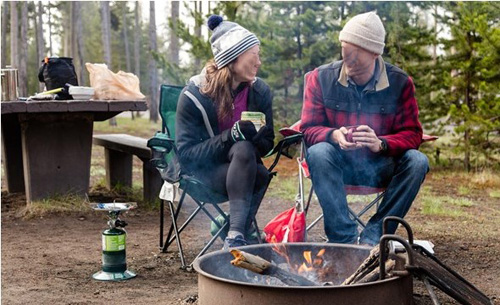
“All food and food containers must be within 6 feet of an awake person” when food is out on a picnic table or otherwise not properly stored. Read more at campground regulations And there is much more on food storage in the compendium, as well as individual park webpages on food storage in general and food storage while backpacking and climbing. “If your food is stored improperly, you will be cited for improper food storage (fine of up to $5,000). . . ”
“food storage regulations have the force and effect of federal law: Failure to store your food properly may result in impoundment of your food or car and/or a fine of up to $5,000 and/or revocation of your camping permit.”
Curry Village had this warning:
“Guests who don’t comply with our food storage policies may receive a fine up to $5,000.00 and be removed from the Park. Vehicles used for food storage may be impounded.”
The Yosemite Valley Lodge has warned:
“Cooking or open flames are not permitted in your room or on the premises. You must use designated picnic areas such as Swinging Bridge or Lower Falls picnic area.
– – – – – – – – – – – – – – – – – – – – – – – – – – – – – – – – – – –
Smoking of cigarettes, cigars, use of e-cigarettes and similar devices are prohibited:
•In all public buildings, including concession buildings
•Within 25 feet of any building, except those used as a single family residence.
(“Concession buildings” includes all hotel rooms, cabins, tent cabins, stores, restaurants, etc.)
Your overnight accommodation may have you initial and sign a statement when you check in that says, in part: “I/we understand Yosemite National Park Lodges are smoke-free environments. A $250 fee will be assessed for smoking in a guest room. Designated outdoor smoking areas are available.”
Some dining venues will have a sign, some will not:
– – – – – – – – – – – – – – – – – – – – – – – – – – – – – – – – – – –
36 CFR §2.20 –
SKATING, SKATEBOARDS and SIMILAR DEVICES
•The use of roller skates, skateboards, roller skis, coasting vehicles, or similar devices are allowed only in the following areas:
•Yosemite Village Mall
•Bicycle paths in Yosemite Valley . . .
• Campgrounds
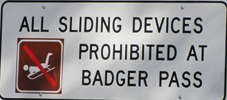
– – – – – – – – – – – – – – – – – – – – – – – – – – – – – – – – – – –
At most trailheads there are nearby restrooms. On some hikes you will find backcountry outhouses (many composting with an upstairs entrance), but if you must dig a hole for your waste:
36 CFR §2.14 –
SANITATION and REFUSE
(b) Conditions for the disposal, containerization, or carryout of human body waste have been established as follows:
•In non-developed areas, solid human waste and service animal waste must be buried at least 6 inches deep in the soil and at least 100 feet from trails, campsites and bodies of water.
•During winter use, snow should be removed and waste buried at least 6 inches deep in soil or waste should be carried out and disposed of in a vault toilet.
•Toilet paper and feminine hygiene products must be packed out.
•Solid waste excreted while on any climb in Yosemite National Park must be placed in a small container carried off the climb and disposed of in one of the vault toilets provided by the NPS
Some other National Parks have other depths / distances, so again, anything at this webpage could change with little notice, and readers of this website should follow through to the official park webpages and read materials they are given when they get a wilderness permit.
Read more wilderness regulations, including permits info and no-camping zones, at: https://www.nps.gov/yose/planyourvisit/wildregs.htm
– – – – – – – – – – – – – – – – – – – – – – – – – – – – – – – – – – –
PS. 36 CFR §2.15 –
PETS
1) The following structures and/or areas are closed to the possession of pets:
•All trails.
•Non-developed and designated Wilderness areas.
•Specific areas as posted by signs.
•O’Shaughnessy Dam
•Camp 4 and backpackers’ campgrounds
•When snow depth is sufficient for skiing, pets are not permitted on unplowed roads
The following structures and/or areas are open to the possession of pets:
. . . When leashed, on fully paved roads, paved sidewalks, and bicycle pathways. . .
“Individuals leaving pets unattended or in violation of California Penal Code 597.7(a) are subject to immediate impoundment of their property/pet.”
Not every rule is in the compendium. Read more about pets at: https://www.nps.gov/yose/planyourvisit/pets.htm, which includes ” pets must be restrained on a leash not more than six feet long or otherwise physically restrained”
You can find wild animals anywhere in the park and do not want your dog to personally meet one of them, such as this bobcat on a path at a Yosemite hotel:
or this coyote walking just outside the fence at a Yosemite swimming pool:
or even more fun, picture your off leash dog wanting to greet a skunk, such as this one on the grounds of a Yosemite hotel (photo courtesy of Harold (Harry) Bradbury):
Take the leash off your dog for just a moment and your dog might need a technical rescue, in this case the rescue lasted until after sunset as sleet and rain fell:
Code of Federal Regulations about pets.
– – – – – – – – – – – – – – – – – – – – – – – – – – – – – – – – – – –
36 CFR §4.21 –
SPEED LIMITS (which are all subject to temporary or permanent change, please watch for signage).
“The following speed limits are established for the routes/roads indicated:
•The maximum speed on park roads is 35 mph unless posted otherwise.
•When and where chain controls are in effect, the maximum speed is 25 miles per hour.
•The speed limit approaching and leaving all entrance station areas is 20 miles per hour.
•When the Yosemite Valley special use lane is in effect, the maximum speed is 25 miles per hour on Southside Drive from El Capitan Cross over to Sentinel Cross over when posted.”
– – – – – – – – – – – – – – – – – – – – – – – – – – – – – – – – – – –
Yosemite driving regulations from 1913 included:
“Time and speed restrictions: Automobiles are restricted to an approximate speed of 10 miles per hour on rolling mountain country . . .”
“Cars may leave Yosemite Station going out of the valley between the hours of 6 and 7.30 a. m. every morning, but at no other time during the day.”
“Every person presenting a car for admission to the park will be required to satisfy the guard issuing the ticket of passage that the brakes of his automobile are in first-class working order and for this purpose all automobilists will be required to effectually block and skid the rear wheels of their automobiles with either the foot or hand brakes or such other brakes as may be a part of the equipment of the machine.”
“All motor cycles are forbidden to enter the park.”
– – – – – – – – – – – – – – – – – – – – – – – – – – – – – – – – – – –
Other park webpages with more detailed rules than the Superintendent’s Compendium include:
Bicycles: “Each season, plants are crushed from bicycle travel in meadows, campgrounds, and picnic areas. Please respect park resources and keep bicycles on paved roads and paved trails.
They are not allowed to travel off-trail, on unpaved trails, or in wilderness areas. Mountain biking opportunities are available in designated areas outside of Yosemite. Bicyclists under 18 years of age must wear a properly fitted bicycle helmet.” https://www.nps.gov/yose/planyourvisit/safety.htm
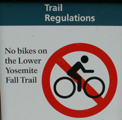 Please walk your bike on the lower Yosemite Falls path/trail, even though it is paved.
Please walk your bike on the lower Yosemite Falls path/trail, even though it is paved.
Campground regulations, including Food Storage, Seasonal limits on Campfires, Firewood collection, Camping Outside of Campgrounds and Sleeping in Vehicles, Maximum number of people per Campsite, Maximum number of vehicles per Campsite, Seasonal limits on number of nights camping, Campgrounds that pets are or are not allowed in, Quiet Hours and Generator Hours, Wastewater disposal, hooking (or not) to Utilities, campground Checkin/Checkout Time and Slacklines, Hammocks, Clotheslines, etc.: https://www.nps.gov/yose/planyourvisit/campregs.htm
In the restroom you might find a sign warning that if you plug in your E-Bike to charge, you can blow a fuse and cut off power to the restroom building:
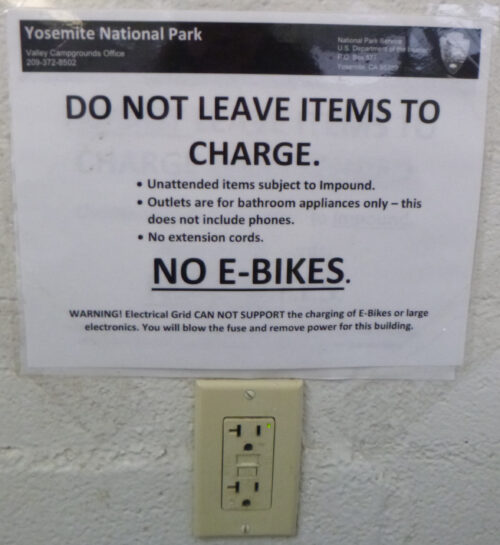
In the campgrounds you must pitch your tent IN your registered campsite, not down by the river at a nice small beach:
If you decide to pitch your tent “out of bounds” you might be lucky and find the violation notice (in this case from the campground host who patrols the campground) on your tent (or in this case, on a portable charcoal grill)
OR you might not be that lucky and could find yourself trying to track down your confiscated tent and gear.
Pitch your tent away from a campground and you can expect a visit from a Ranger:
Camping “out-of-bounds” in 1951, with a NO CAMPING sign :
Read about climbing regulations, the reasons behind them and practical advice on how to follow the rules, including fixed ropes, permits and sleeping on big walls, food storage, trash and human waste while climbing, bouldering, slacklining, and bolting ethics at: https://www.nps.gov/yose/planyourvisit/climbing_regulations.htm
and see also permits and logistics of sleeping on Big Walls at: http://www.climbingyosemite.com/services/regulations/
There is fascinating reading on how Yosemite climbers can avoid injuries / stay alive, by Search and Rescue (SAR) Ranger John Dill, (including sections on environmental dangers, descents, big wall bivouacs, unplanned bivouacs, loose rock, climbing unroped, leading, falling, learning to lead, the belay chain, helmets, states of mind, rescues, and risks, responsibility and the limits of climbing), at: climbing advice
“Seasonal Climbing Closures March 1 – July 15
Please respect Peregrine Falcons nesting in Yosemite by complying with seasonal climbing closures. Starting Monday, March 1, 2021, closures go into effect at Arch Rock, B.O.L.T. Wall, Fifi Buttress, El Capitan, Fairview Dome, Hetch Hetchy, Lost Arrow Spire, Mt. Broderick, Rhombus Wall, the Rostrum, Sentinel Rock, Washington Column and Wawona Dome. If you want to climb at any of these areas, please check the closure notice (posted at http://www.nps.gov/yose/planyourvisit/climbingclosures.htm) first to make sure you are complying with the closures and not disturbing any nesting peregrines. Thank you for helping to protect Yosemite’s nesting peregrine falcons!”
https://www.nps.gov/yose/planyourvisit/climbingclosures.htm
“On May 11, 2021 Yosemite National park announced:
Yosemite National Park To Implement Pilot Overnight Climbing Permit System Beginning Friday, May 21, 2021 – Yosemite News Release Release May 7, 2021
Yosemite National Park – All visitors planning to overnight on any rock climbing routes in Yosemite National Park will be required to obtain an overnight wilderness climbing permit beginning on May 21, 2021. This pilot program is being implemented to better understand how park visitors use Yosemite’s big walls and to help improve climbing wilderness ethics and reduce negative human impacts associated with overnight big wall use.
Overnight climbing permits will be available beginning at 8 a.m. on May 14, 2021. For the duration of the pilot program, these permits will be free. Please visit https://yosemite.org/climbingpermits/ to learn more.
For more detailed information on climbing in Yosemite National Park, please visit: https://www.nps.gov/yose/planyourvisit/climbing.htm.
This program will be a 2-year pilot.”
“80 percent of entrance fees stay in the park and are devoted to spending that supports the visitor.”
The https://www.nps.gov/yose/planyourvisit/fees.htm park entrance fee which addresses “many important maintenance and infrastructure needs,” covers your entrance into the park for your choice of payment for a length of time and size / type of vehicle, free parking at the various day use parking lots, use of trails / visitor centers, Ranger programs, walks, talks (but not fee based programs by park concessionaires, see lists of dates/times of each in the park newspaper).
Your park entrance fee does not cover the cost of your campsite or overnight accommodation.
See also information about annual passes to all National Parks (or just to Yosemite), passes for seniors, free passes for military, free access (permanent disabilities) passes, some of which “may provide a 50 percent discount on some amenity fees charged for facilities and services such as camping, swimming, boat launch, and specialized interpretive services.”
During times when a permit is required to enter Yosemite National park, “Entering the park without a permit or valid self-certification card is a violation of federal regulations, with maximum penalties of a $5,000 fine and/or up to six months in jail. Rangers are on patrol when entrance stations are unstaffed.”
Fishing regulations are at: https://www.nps.gov/yose/planyourvisit/fishing.htm
Read all about Half Dome permits at: https://www.nps.gov/yose/planyourvisit/hdpermits.htm
Rules for use of Other Power Driven Mobility Devices (OPDMDs)
including maximum speed, where they can and can’t be ridden, minimum age of users, and more
https://www.nps.gov/yose/planyourvisit/upload/access.pdf
The most current restrictions that affect some RVs and all trailers and tips for towing a trailer over Tioga Pass are at: https://www.nps.gov/yose/planyourvisit/restrictions.htm
The reason you should not ignore a sign saying you can’t turn your large RV in a specific direction on a given road, is that it will pull out into oncoming traffic because the roadway is too narrow and has a curve right in front of you.
Weddings
Park Service rules about permits for Weddings & Commitment Ceremonies in Yosemite National Park, with links to wedding locations/ rules for their use in Wawona, Glacier Point, Tuolumne, Big Oak Flat and in the valley including using the Chapel, are at:
https://www.nps.gov/yose/planyourvisit/weddings.htm
And no, you can’t photograph the wedding using a drone “the use of drones is prohibited while visiting the park and should not be utilized at any time. ”
Wilderness permits at: https://www.nps.gov/yose/planyourvisit/wildpermits.htm
– – – – – – – – – – – – – – – – – – – – – – – – – – – – – – – – – – – – – – – – – – – – – – – – – – – – – – – – – –
It is ILLEGAL TO JUMP OR DIVE OFF BRIDGES in Yosemite National Park.

Yes, there is an actual Yosemite regulation: “Jumping or diving from any bridge is prohibited… This activity has resulted in severe injuries to persons who have jumped from bridges into shallow water. Also, people jumping from bridges cause increased water turbidity and shock waves, both of which have a detrimental effect on fish and other components of aquatic ecosystems.”)
Another reason to discourage your group from jumping is that they are role models for others.
They might be athletes good enough at jumping to not slip or accidentally lean backwards and hit their tailbone or the back of their head on the bridge as they jump, but a child who sees them and tries it might not be.
And if one of the group is not sure about it and is being pushed (literally or not) to jump, they might start to jump and their brain will re-consider/panic and they might hesitate in mid-jump, not jump out and away from the bridge, again causing them to impact part of their body on the bridge.
Parents have been cited and paid fines for encouraging their under-age children to illegally jump off bridges.
– – – – – – – – – – – – – – – – – – – – – – – – – – – – – – – – – – – – – – – – – – – – – – – – – – – – – – – – – –
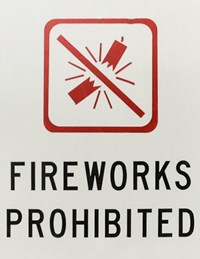 “No fireworks of any kind are allowed in Yosemite National Park. Fireworks disturb wildlife and greatly increase the risk of wildfire.”
“No fireworks of any kind are allowed in Yosemite National Park. Fireworks disturb wildlife and greatly increase the risk of wildfire.”
From an NPS news report: “According to the National Fire Protection Association, fireworks start an average of 18,500 fires per year and result in an average of $43 million in direct property damage. A random spark can quickly escalate into a wildfire, especially under dry, windy conditions.”
– – – – – – – – – – – – – – – – – – – – – – – – – – – – – – – – – – – – – – – – – – – – – – – – – – – – – – – – – –
Code of Federal Regulation Title 49, section 393.90 includes the rule enforced on Yosemite Valley free shuttle buses that passengers must the stand behind the yellow line (see photos below).
Also of interest could be these bus rules, logistics and courtesies
– – – Most drivers prefer you wait until everyone has finished getting off before you get on, the same as any transit system in the rest of the world.
Everyone should enter the bus at the front door.
No one should get on at the back EXIT ONLY doors unless the driver says it is okay.
Because the lines can get a bit long, and some people try to crowd on before others who have been waiting longer, you might find ropes and stanchions as an organizer for the line, with signs for which end to enter the lines and which end will get on the bus first.
– – – Most drivers prefer you exit from the back, but will sometimes tell passengers they can exit any door. OR, if you ask politely, the bus driver might let you and your huge backpack / stroller exit from the front where you got on instead of going all the way to the rear exit, but be sure to ask before the last moment.
– – – Please take the baby out of the stroller and fold up the stroller.
– – -You can wear your ginormous backpack or put it in your lap, but it shouldn’t have a seat for itself if the bus is crowded.
– – – No inflated rafts, tubes, etc. are allowed, but are okay DE-inflated if they fit on your lap. (An inflated raft is too big to fit down the aisle and it’s wet, sandy and or dirty and gets others on the bus dirty. Either sew a large drawstring bag or buy a duffle bag or large backpack big enough to fit each fully deflated raft/your lifejackets in. It won’t be much bigger than a big backpack that others might be carrying on the bus. See Yosemite Valley rafting advice.)
– – – You can’t stand next to the driver. Everyone standing in the aisle must be behind the yellow line near the front of the bus:
You can stand off-side of the main isle at the back step, but just not in the area where the back doors open/close, yellow in the picture below:
– – – Keep children under control. Running or horseplay on the bus, including standing on the seats, can be dangerous.
– – – All the free Yosemite shuttle buses are accessible with wheelchair lifts and tie‐downs. Maximum size for wheelchairs on shuttle buses and tour buses is 24 inches wide x 46 inches long with a weight limit on tour buses of 750 pounds. Bus drivers will help passengers on and off buses or notify them of stops. If you need assistance, ask the bus driver.
– – – Any time usage is high, especially on a summer afternoon, standees need to move to the back to let more people on. (No, not contorting your body to fit as crowded in as in parts of China where people are reportedly literally face to face.)
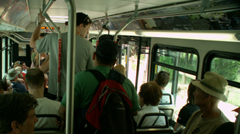
– – – As you know from other transit systems, conversations, both in person, over the phone (if you can get reception) and whatever it is you are listening to on headphones should be at a low volume for everyone’s sanity.
– – – If, for example, someone uses a seat for their day pack on a crowded afternoon, or is yelling into their cell phone, there is no good reason to confront them. You are in a tight space.
Let the bus driver deal with rude or obnoxious passengers.
Hey, you are on vacation, and the ride will be short.
– – – no dogs (or any pets) are allowed on the shuttle buses (or on trails).
Yosemite valley free shuttle bus describes the main year-round route of the free shuttle bus, and has maps of the areas at the bus stops, a list of stops and what you can find at each, hints to save time using the shuttle bus, best bus stops for and/or links to the following Yosemite Valley activities: art classes, bike rentals, bike paths, campsite availability, grocery store, hikes and their trailheads (start of the trail), horseback riding, ice skating, free and fee internet access, laundromat, lost and found, photo walk, rafting, Ranger talks/walks/evening programs, restaurants & cafeterias / pizzerias / grill / deli, rock climbing lessons, places to get a shower, ski / snowboard / snow shoe walk, picnic, stargazing, swimming, waterfalls. There are also links to local weather and air quality reports AND notes about the best bus stops for overnight accommodations, day use parking.
– – – – – – – – – – – – – – – – – – – – – – – – – – – – – – – – – – –
Drivers should note that there have been sections of road in Yosemite Valley, part of the year, with two lanes (usually) in the same direction, with the right lane ONLY for the free shuttle buses, ambulances, ski bus, commercial vehicles with ten or more passengers. The NPS says: “The bus lane ensures emergency vehicles can respond to incidents when traffic is backed up and provides preference for mass transit.”
Parking and traffic jams in Yosemite valley tips and tricks has the above advice, with maps of each of the three major day-use parking lots, with advice to help you NOT get a Yosemite National Park traffic or parking ticket, and not contribute to preventable traffic backups. And some details of where you can’t park in Yosemite, or can’t park without a permit.

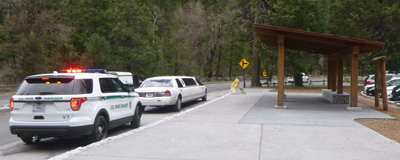
How much will I have to pay for my ticket?
Sometimes the amount of a fine is on the sign informing you of an action you should not take:
The park concessionaire warned guests:
“Guests who don’t comply with our food storage policies may receive a fine up to $5,000.00 and be removed from the Park. Vehicles used for food storage may be impounded.”
The park service answered this question:
“What if I don’t put on (snow) chains?
You will be subject to a citation (up to $5,000) if you fail to put on chains when required. Further, if you don’t have chains with you, you may have to call a tow truck to supply chains for you (this could cost up to a few hundred dollars and is not covered by AAA; the wait can be several hours).
Countless accidents are caused by motorists who lose control because they don’t have chains, and many of those drivers have winter driving experience. Don’t be responsible for injuring someone, damaging vehicles, or inconveniencing hundreds of other park visitors by causing an accident: use chains when required and drive with caution.”
Will I have to go to court?
For some, a mandatory appearance in court may be required at the discretion of the citing officer and if the person does not appear, a judge “may issue a warrant of arrest for that person.”
For other citations / tickets issued in National Parks, people can pay without coming to court,
subject to change, but by way of examples, (as of 2020, last revised 03/01/2010):
While camping, creating unreasonable noise between hours of 10:00 PM and 6:00 AM: $150 or mandatory appearance in court
Exceeding Speed Limits
1 – 15 mph $100
16-25 mph $180
26 or over $350
Operating a motor vehicle in a manner which unnecessarily causes its tires to squeal, skid or break free of the road surface: $150
http://www.caed.uscourts.gov/caednew/assets/File/Collateral%20Forfeiture%20(Bail)%20Schedule.pdf
From the Yosemite webpage: “Failure to store your food properly may result in impoundment of your food or car and/or a fine of up to $5,000 and/or revocation of your camping permit.”
and from an inter-agency report:
“The following restrictions exist year-round on federal public lands:
• Operating a chainsaw is prohibited in national parks. Operating a chainsaw on national forest lands is permitted only when equipped with a USDA or SAE approved spark arrester that is properly installed and in effective working order. Operators must also carry a chemical pressurized fire extinguisher with a minimum rating of 2A and one round point shovel with an overall length of at least 36 inches.
• Discharge of fireworks and use of explosives requiring blasting caps are prohibited.
Violation of these prohibitions is punishable by a fine of up to $5,000 for an individual or $10,000 for an organization, and/or by imprisonment for more than six months.”
When Yosemite trail crews have closed a trail, (including sometimes overnight, but often not on weekends) “there is a $280 fine for entering a closed construction zone.” The trail use might not be safe or they might even be performing blasting operations, so don’t ignore trail closure signs / notices, or go through closed gates.
Top reasons not to speed in a National Park
– – – – – – – – – – – – – – – – – – – – – – – – – – – – – – – – – – – – – – – – – – – – – – – – – – – – – – – – – –
The park service says:
“Visitors to Yosemite National Park are the park’s most important guardians. With Yosemite’s nearly four million people watching over its special plants, animals, historic, and archeological sites, imagine how well-protected these park resources could be!
During your visit to Yosemite, be aware that there are people who either intentionally or unknowingly harm park resources. Please contact a park official if you see any of the following illegal acts:
feeding or approaching wildlife
hunting animals
collecting reptiles and butterflies
collecting plants
picking up archeological or historic items such as arrowheads
possession of metal detectors or using them to locate and collect historic objects
driving vehicles into sensitive meadows and off roadways, biking off of paved roads
camping outside of designated campgrounds
using weapons, possession of weapons inside federal facilities
possessing or using marijuana, including medical marijuana
operating an unmanned aircraft system (“drone”)
If you see activities that could harm people or park resources, jot down any descriptions or a vehicle license plate number and contact the park dispatch office at 1 209/379-1992; if someone’s life is in danger, call 911.”
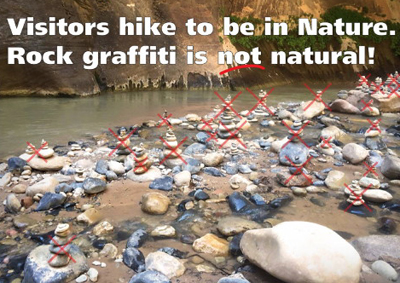
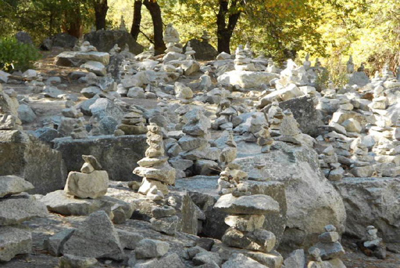
Rock graffiti (building cairns, stacking stones) is not natural. It is not worse than carving your initials in a tree, or scratching your name on sandstone, but it is still graffiti and vandalism.
Zion National park notes:
“Rock stacking in national parks may seem harmless,
or even fun to make, but we invite you to reconsider the problem they pose from a broader perspective. On the one hand, hiking in nature should provide an escape and a refuge from the everyday mundane life. That refuge, ideally, should be in an unadulterated natural setting (or minimally so). Rock graffiti, even if seemingly impermanent, disturbs the natural state of the environment for other visitors, and have a permanent ecological impact. Also, be aware that it
is considered by the National Park Service as a form of vandalism
and it is illegal… ”
In the LA Times we read about dismantling rock cairns in Yosemite:
https://www.latimes.com/california/story/2023-07-19/yosemite-national-park-rock-cairns-problem
” . . . Constructing such towers goes against Leave No Trace ethics, a set of seven principles designed to educate members of the public on minimizing their impact on outdoor spaces and that the National Park Service advises its visitors to follow.
According to the park service, cairns are most commonly used to designate hiking routes. Typically cairns should be assembled only by rangers and trail workers, according to the park service.
“When used appropriately, rock cairns are great for navigation, safety, and delineating a new or hard-to-follow trail,” Yosemite said on its Facebook post.
The spring and summer months are peak seasons for the National Park Service system, with flocks of tourists packing parks across the country.
The park posted a video on Facebook (https://www.facebook.com/YosemiteNPS/videos/841925900982269/) earlier this month instructing visitors to stop building large rock towers, called cairns, and dismantle any they find. In the video, a wilderness restoration ranger gently shoves over a cairn, which appears to be several feet high.
“This dramatically oversized cairn is a mark of human impact and is distracting in a wilderness setting,” the post read. “Building rock cairns also disturbs small insects, reptiles, and microorganisms that call the underside home!”
– – – – – – – – – – – – – – – – – – – – – – – – – – – – – – – – – – –
The Park service says: “Graffiti is vandalism, and is extremely difficult to remove.
Repair of vandalized sites, if possible, is costly and time consuming,
and often cannot restore the site to its former condition.
These acts are also illegal.”
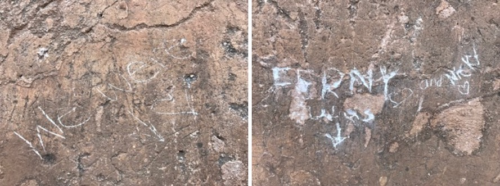
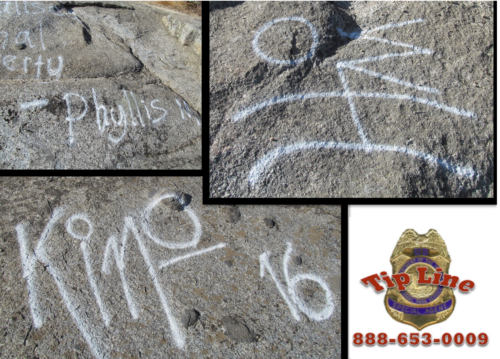
“If you see something suspicious in any National park service location, or if you have information that could aid in an investigation, tell us about it. Talk to any NPS employee for help in reporting suspicious activity or give the Special Agents of the NPS Investigative Services a call.”
Outside Magazine reporter Rachel Monroe wrote “the 33 special agents assigned to the Investigative Services Branch handle the most complex crimes committed on NPS land … The elite special agents assigned to the ISB — the National Park Service’s homegrown equivalent to the FBI — are charged with investigating the most complex crimes committed on the more than 85 million acres of national parks, monuments, historical sites, and preserves administered by the National Park Service, from Alaska’s Noatak National Preserve to Hawai’i Volcanoes National Park. They have solved homicides, tracked serial rapists hiding in the backcountry, averted kidnappings, and interdicted thousands of pounds of drugs. They’ve busted a reality TV host who poached a grizzly bear and infiltrated theft rings trafficking in looted Native American artifacts. But the ISB remains relatively unknown to the general public and even to fellow law enforcement … “
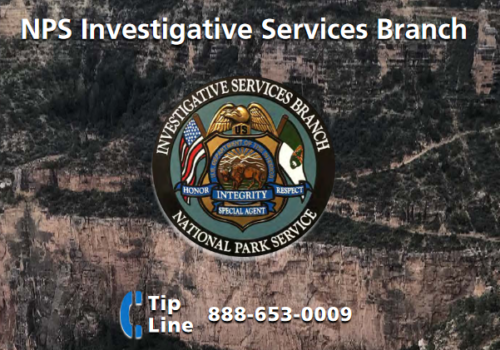
– – – – – – – – – – – – – – – – – – – – – – – – – – – – – – – – – – –
And from other National parks:
Backpacking / hiking in Glacier National Park in the northern part of Montana?
Crossing the border during a hike / backpack into Canada without following special procedures can result in a $5,000.00 fine.
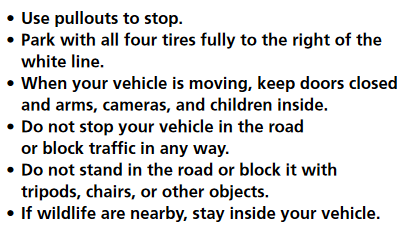
These regulations from Grand Teton National Park are much the same as in Yosemite:
“Anyone illegally operating an unmanned aircraft in the park may be issued a mandatory court appearance with the maximum penalty of six months in jail and a $5000 fine.
The maximum penalty for feeding park wildlife is a $5,000 fine and up to one year in jail.
Operating a motor vehicle off roadways is a violation and subject to a fine up to $5,000 and/or up to six months imprisonment. Additionally, the System Unit Resource Protection Act provides that any person or instrumentality that destroys, causes the loss of or injures, of any National Park Service resource is liable for response costs and damages.
Visitors should never leave a fire unattended. The fine for an abandoned campfire is $225, but campers can also be held liable for suppression costs if their campfire becomes a wildfire.
Do not park vehicles in tall dry grass,
since hot tailpipes can cause fine fuels to catch on fire.
If pulling a trailer, ensure your chains are clear of the ground as small sparks could start roadside fires.
![]()
Also perhaps of interest:
“Choosing to leave the trail and scramble in boulders below waterfalls can have a costly outcome. Is getting closer really worth the risk?”
https://www.facebook.com/YosemiteNPS/videos/462862757639618/
People climb over barriers meant to protect them and as a result slide over waterfalls in Yosemite. They ignore warning signs.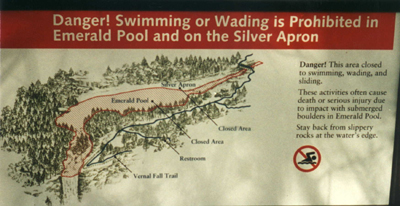 fatal, near fatal or close call incidents/accidents in camping, backpacking, climbing and mountaineering
fatal, near fatal or close call incidents/accidents in camping, backpacking, climbing and mountaineering
– – – – – – – – – – – – – – – – – – – – – – – – – – – – – – – – – – –
Selfies can be great, OR dangerous. The use of cell phones for photography has made preventable injury or even death by selfie common. They were only taking a selfie
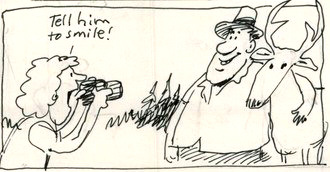
– – – – – – – – – – – – – – – – – – – – – – – – – – – – – – – – – – –
 You can’t always expect a helicopter rescue
You can’t always expect a helicopter rescue
Hotel, cabin and tent cabin choices in Yosemite valley are at: Yosemite Valley accommodations
Curry Village (briefly named Half Dome Village) tent cabins tips and tricks
You can find basic to extravagant, (a few with a dress code),
casual, fast (grab and go)
or with table-side service,
indoor and outdoor food service
at multiple locations in Yosemite Valley, as well as four grocery stores
all of which are served by the Yosemite valley free shuttle bus.
– – – – – – – – – – – – – – – – – – – – – – – – – – – – – – – – – – –
swimming in Yosemite including thunderstorms, bacteria in the water, safety issues, favorite beaches, swimming pools with lifeguards.
– – – – – – – – – – – – – – – – – – – – – – – – – – – – – – – – – – –
Why you should wear a lifejacket.
rafting in Yosemite Valley
Parking difficulties and somewhat preventable traffic jams in Yosemite
– – – – – – – – – – – – – – – – – – – – – – – – – – – – – – – – – – –
Where should you go to get that great photo in Yosemite?
Where can I take a photo that looks like the one on a Yosemite postcard I just bought?
Places to take photos of Half Dome, Bridalveil Fall, El Capitan, Yosemite Falls and Staircase Falls.
– – – – – – – – – – – – – – – – – – – – – – – – – – – – – – – – – – –
The Yosemite Guide newspaper, https://www.nps.gov/yose/planyourvisit/guide.htm which you will be offered a copy of as you pay at an entrance station to enter the park, (or you can read, download or print in advance) has hours of operation for visitor centers, museums, tours, stores, food service, post office, laundromat, showers, auto service, gas stations, and a calendar of park activities including Ranger walks.
– – – – – – – – – – – – – – – – – – – – – – – – – – – – – – – – – – –
Cell phone service is NOT available in all parts of Yosemite.
It is usually okay in the vicinity of the Exploration Center.
Many years we got 4 bars for Verizon and 3 bars for AT&T near the Exploration Center, versus 2 bars for each at the Ahwahnee and 2 bars Verizon, 1 bar AT&T in Upper Pines campground, at the Yosemite Valley Lodge, Curry Village and some other locations in East Yosemite Valley.
The park service said: “Cell phone coverage in Yosemite is spotty . . . Cell service is often impacted during daily peak visitation by the large number of people trying to access limited service; if you have four bars of service, but you can’t get a signal, this is why . . . cell coverage depends on your phone, the cloud cover and other seemingly mysterious factors and is not always reliable. ”
Outside of Yosemite valley, the Tuolumne Grove, Olmstead Point and Badger Pass has been 1 bar Verizon, zero bars AT&T. Glacier Point and the top of Half Dome often have 3 bars Verizon, 2 bars AT&T.)
——————————————————————-
The author of this webpage, (written as a reading assignment for my students), does not give any warranty, expressed or implied, nor assume any legal liability or responsibility for the accuracy, completeness, or usefulness of any information, product, or process included in this website or at websites linked to or from it. Users of information from this website assume all liability arising from such use.
